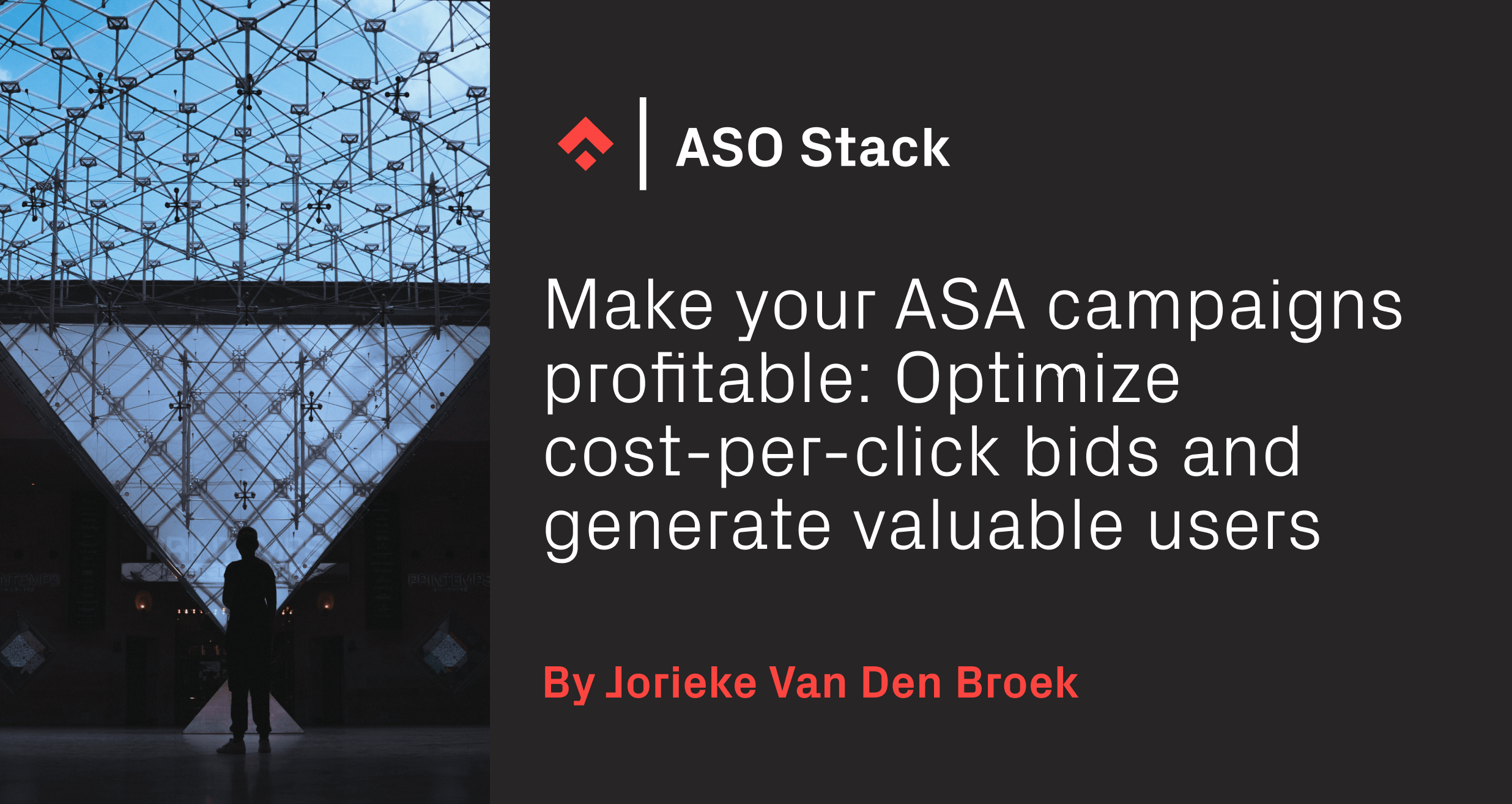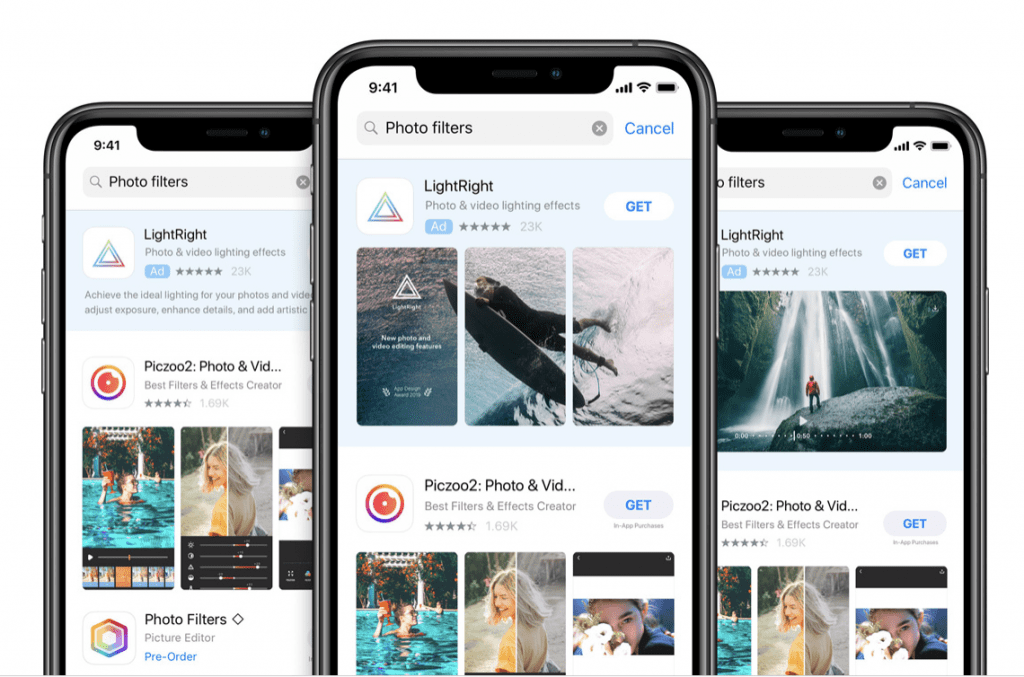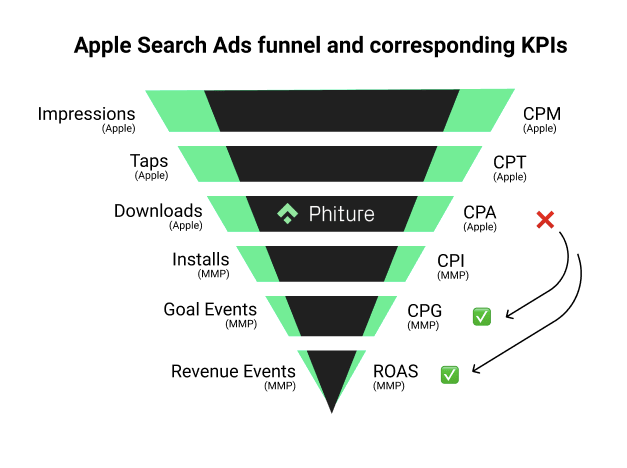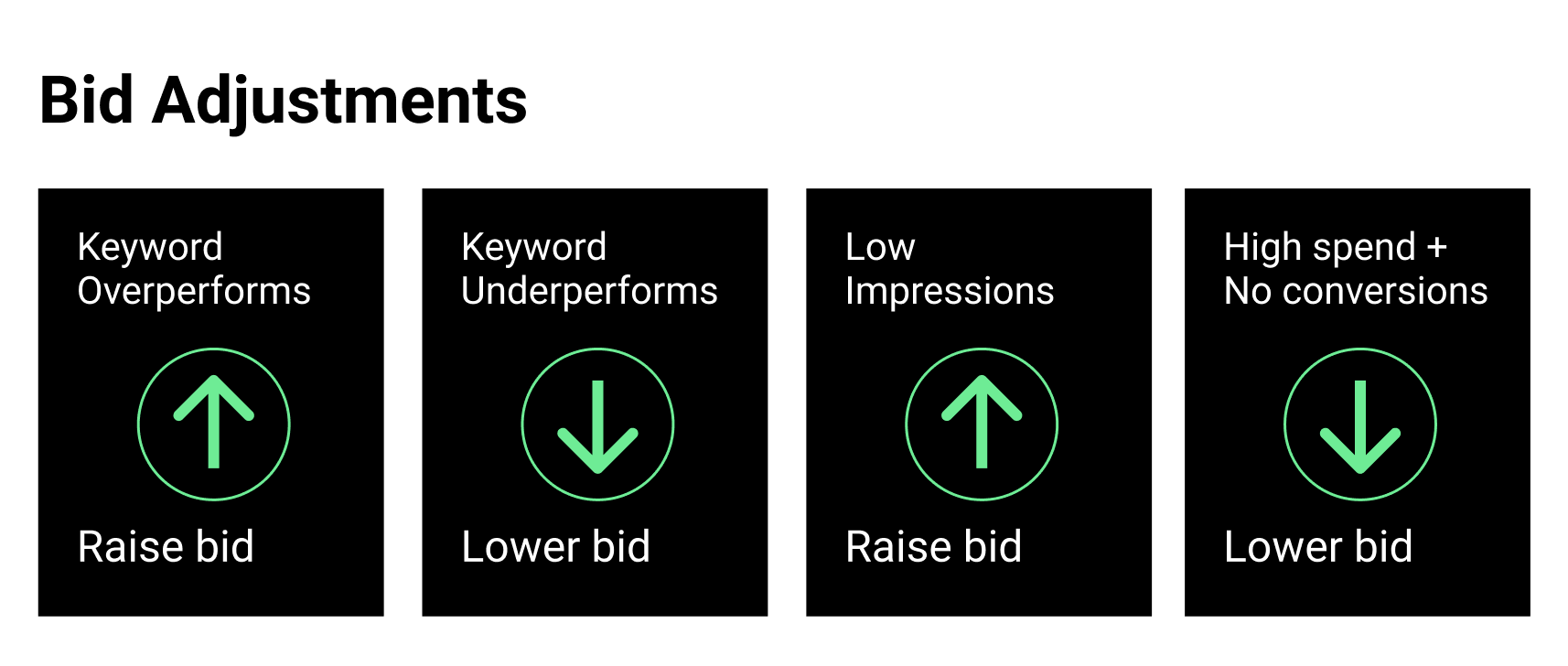
Apple Search Ads (ASA) offers a way of marketing your app directly to those users searching for an app in the app store. Due to a search of this nature, where users are looking for something specific, Apple Search Ads is a high, intent-driven channel, which can be very efficient in converting these users who are searching to fulfill their needs.

Here is how ASA works: for a specific search term, users will see a specific advertisement as a top result in the App Store above all organic listings. As such, ASA provides visibility to your app, even if you are not ranking first organically. The way ASA is set up clearly increases app discoverability and generates big advantages for apps. This is because users in the App Store, by having high intent, are more likely to perform certain actions such as downloads, but also lower-funnel events in your app that can generate revenue.
One of the most powerful strategies for optimizing and scaling your Apple Search Ads campaigns is fine-tuning the cost-per-tap (CPT) bid. The CPT bid is essentially the amount you are willing to pay for a tap (which is the same as a click, but on mobile). They are essential in order to bring in a bigger volume for a better price.
In this article, we are going to cover a couple of best practices that will help you get a better grip on how you can leverage your CPT bid for a better overall performance. We will discuss why you should optimize for events that take place at the lower end of your User Acquisition Funnel (e.g. purchase events) and provide a step-by-step guide on how you can do this. Before digging in, let’s first discuss exactly how the Apple Search Ads auction works.
How does the Apple Search Ads auction work?
Apple Search Ads work on a cost-per-tap model. You pay for your ad only when a user taps on it. ASA is based on a second-price auction, meaning that the CPT you pay is based on the amount the nearest competitor is willing to pay –– this will never exceed your maximum CPT bid.
There are two important elements that play a big role in your chances of winning the Apple auction. First, the max CPT bid you’ve set, and if it is high enough to beat your competition. Second, the relevance of an ad. Apple wants to create an optimal experience for its users, hence, the likelihood of a tap happening will be important. To achieve this, Apple will look at the historical tap-through rate (TTR), which indicates how many users have seen your app and tapped on it. If there’s no such TTR available, ie. you’ve never bid on the keyword before, it can make assumptions based on the relevance of your metadata to the keyword. If there are many users that tap on your ad after seeing it, we can assume that your app is what they are looking for, and your relevancy will be high.
Because of the importance of the relevancy score, we need to ensure that we have a healthy TTR. For this, we need to pay attention to the keywords you use in your metadata. Do they describe the functionalities of your app to make sure that if users search for a certain term, they find what they are looking for? Moreover, creative assets in your app store will also impact the TTR. Therefore, it is important the screenshots that are used match the user’s expectation of an app. To optimize the conversion rate of users through visual assets, you could implement Creative Set Tests in Apple Search Ads, which can offer an indication of how likely a user is to download an app based on one screenshot. Finally, your app’s icon is another relevancy element to take into consideration: aim for a simple, distinctive and understandable icon, so users are more likely to tap on your ad.
In sum, apart from setting an optimal CPT bid, it is also very important to have a relevant ad, and that you target relevant keywords. For example, let’s say you have a weather app, and you target very popular keywords like “music” or “concert”. The chances you have of winning the auction are very low; even if you do win the auction, and users see your app, it’s highly unlikely they will tap on it as it’s not relevant to their search.
Now that we’ve briefly discussed how you can improve the TTR, the other main element that can give you a better chance of winning the auction is the bid. Let’s now touch on why optimizing for low-funnel events is important in order to obtain the optimal CPT bid, which aims to fulfill your revenue and growth objectives.
Optimize for low-funnel events.
If you run an ad campaign, your goal could be to generate a sustainable return on investment (ROI), defending your brand, and increasing market share by growth and/or capturing traffic from your competitors. To improve the effectiveness of your campaign and ensure a positive ROI, we recommend that you optimize for low-funnel events and have a performance-based ASA strategy. This way, you target the keywords that will bring you users with a high intention of converting in your app, and thus, generate revenue and growth for your business.
Unfortunately, the Apple console cannot provide this data as it only provides an overview of your ad’s performance up until the download event (which happens in the App Store). If you stop tracking your performance at cost per download, this will give you an indication of how much you spend on acquiring a new user; but the insight you are missing here is that you don’t know how valuable this user is, i.e. how much money the user will spend in your app, how engaged a user is and how long they are active in the app. A series of important growth metrics, such as return on ad spend, (ROAS) will be missing. Since those will be pivotal in making your business profitable and sustainable, you’ll want to make sure you’re tracking those. Now you can see why it’s important to look further down your app’s acquisitions funnel, and not stop at monitoring key performance indicators (KPIs) that are visible in the Apple Search Ads console.
The image below is a visualization of what the Apple Search Ads funnel looks like and the corresponding KPIs we measure. In the funnel, we also want to emphasize that it is the best practice to look at low-funnel events like cost-per-goal events, for example, cost per purchase, or ROAS in order to ensure the acquisition of high-value users.

Using a mobile measurement partner (MMP) such as Adjust or Apsflyer will help you obtain insights on how the users you acquired behave in your app. With these insights, you could set up and measure certain in-app events, such as the placement of an order (purchase) or the creation of an account (sign-up). As such, if you want to run performance-based campaigns, it’s highly recommended that you integrate one of these.
On top of having an MMP, using a third-party tool to manage your ASA campaigns (like Search Ads HQ or Kenshoo), could help with optimizing for low-funnel events. These tools will give you a holistic view of all the data coming from Apple’s side (impressions, taps, downloads), and data coming from the MMP (installs, in-app events, revenue). The integration of these tools facilitates the ‘digestion’ of information and management of the campaigns while optimizing for low-funnel events. We highly recommend optimizing your bids for these low funnel-events e.g. increasing bids for keywords that generate lots of purchases, or decreasing bids for keywords that aren’t bringing in value traffic. You will ensure the acquisition of users who generate revenue, which enables you to have a sustainable business model and acquire users for less than their expected LTV.
Now that we have discussed how the Apple Search Ads auction works, and that it’s best to optimize for actions that happen lower in the funnel, let’s cover some practical tips on how to optimize your ASA account.
In the next section, I will provide you with some optimization recommendations, and a step-by-step overview of how you can find your optimal CPT bid. We will discuss how you can leverage CPA goals to improve performance on the ad group level, how bid optimization can be a great tool and we’ll talk about some other topics that can help you optimize your campaigns.
Optimizing to obtain the optimal CPT bid
First of all, and most importantly, it’s very useful to always have a clear target in mind for what you want to optimize. For example, you could set a ROAS goal of 120%, which means for every $100 you spend on your campaign, you aim to gain $120 in revenue. Or, you could set a target of how much you want to spend on each goal event –– for example, aiming for a cost per purchase event of $50. Setting targets is important because it gives you a tangible objective to work towards and allows you to measure your progress. Second, after your campaign has been running for a day or so, and has generated enough traffic to base your decisions on, you would be ready to optimize your campaign. Without a sufficient number of data points, you’re merely changing the bids and hoping to hit the target.
The points mentioned above are probably the most important to keep in mind when you start your campaigns. However, there are additional things to keep in mind once we kick off ASA: We recommend starting off with bids that are high enough to avoid keywords from not getting significant traffic and staying ‘dormant’. If you start with bids that are too low, some keywords might never ‘win’ the auction; they will have very little impressions, and thus, no data to base your bid optimization decisions on.
When a keyword performs well and brings in traffic or revenue within the set target, we would recommend increasing the CPT bids. And when a keyword is performing outside of its target limit, to lower the bids. So, for example, if our cost-per-goal event target is $50, for a keyword that has a CPG of $23, increase the CPT bid. For a keyword with a CPG of $73, lower the CPT bid. Generally, I recommend to gradually increase or lower bids by approximately 10 or 20%, depending on how well/badly a keyword is performing. If you check performance frequently, you can always lower or increase the bid again.
For keywords that usually have a good performance, but aren’t getting many impressions, increasing the bids might allow them to win more auctions, and in return generate more impressions for users that might convert well.
Another action to take is to ensure you aren’t spending too much on keywords that aren’t bringing in any converting users at all, e.g. not having any goal events, so there won’t even be a cost-per-goal event. I recommend lowering bids for keywords with high spend and no conversion events.

If it’s your first time optimizing ASA campaigns, here’s a practical, step-by-step guide to optimizing your campaigns if you use a third-party tool:
- Keyword level:
- Sort on spend
- Set date range to last 7 days
- Filter on keywords that have a cost per goal event (purchase, subscription, etc.) that is more than the target
- Select keywords and decrease bids by 10-20%
- Filter on keywords that have a cost-per-goal event that is cheaper than the target
- Select keywords and increase bids by 10-20%
- Set date range to last 30 days (to have a little more data to base your decision on)
- Look at keywords with a good cost-per-goal event and a low number of impressions and increase bids
- Look at keywords with a high spend amount and no/a low number of goal events and decrease bids
Setting CPA goals on the ad group level.
After having discussed a few tips on how to optimize campaigns, let’s see how you can leverage another trick to improve the performance of your campaigns: setting a cost per acquisition (CPA) goal on the ad group level. For every ad group, you can set a CPA goal, which should reflect your ideal amount to acquire a new user (e.g. 2€). The CPA goal will let Apple’s algorithm know for which price you would like to acquire a user and it will try to find users who are likely to convert within that set target, trying to prevent acquiring users at a higher cost (the CPA goal will work well and provide satisfying results if the targets are reasonable). Note that when you set targets that are not realistic, this setting might only work slightly or not at all. For example, if your CPA usually lies around $3, and you set a CPA goal of $0.5, you’ve probably set it too low, and the algorithm won’t work perfectly –– it could also prevent you from getting any traffic whatsoever. In short, setting a realistic CPA goal at the ad group level is a great way to direct ads to users that will probably convert within your defined target.
Step by step:
- Ad group level:
- Sort on spend (from high to low)
- Set date range to last 7 days (we recommend you to optimize your campaigns at least once a week)
- Adjust CPA goal for ad groups with a CPA that is above target
Bid Automation:
An intelligent way of tackling bid optimization is automation. At Phiture, we’ve developed scripts that automate bid optimization. The algorithm would use all historical bids and CPTs for a keyword and change bids every hour to find the optimal bid on a built curve –– for example, to optimize revenue per impression. To evaluate the bid optimization script, our team built a bid simulator (see graph below), which enables us to monitor impressions over time given a certain bid.

It will take time to set up an automated script, and you would have to have enough data for it to work properly; but once it’s in place, it could save you a lot of time and trouble. Your bids will automatically be adjusted at any time of day, so you’ll have more time to focus on other strategic or creative efforts.
If you don’t have the time or the resources for building tools such as these, you can leverage a third-party tool to manage your Apple Search Ads campaigns automatically. In SearchAdsHQ, for instance, you can set your own customized, automated rules. The aim of using an automated rule is to help fine-tune your CPT bid based on your target metric. If you use a CPA as a target metric, the CPT bid will automatically adjust based on your target CPA.
If you want to work with rules at the keyword level, to make sure you have enough historical data for your automated rules to work with, it’s suggested to set certain parameters. For example, setting a parameter in which there are more than 5 installs for a particular keyword, or more than 2 goal events –– of course strongly depending on your targets and the strategy of your campaigns.
After applying your rule, your bids will automatically be increased, decreased, paused, and enabled based on the conditions you’ve specified. Hence, automation could save you a lot of time when optimizing your campaigns; but we do recommend that you keep checking up on the performance yourself periodically, in case you need to apply some human logic the machine cannot grasp.
Other elements you can leverage to decrease your average CPT
There are some other elements in ASA that you can tweak in order to improve the performance of your campaign, the overall acquisition costs, and efficiency of your campaigns.
Negative keywords or pausing keywords
You can use negative keywords to make sure that there are no irrelevant search terms draining your ad budget. Negative keywords prevent ads from being displayed for particular keywords. Excluding low-relevance search terms with the help of negative keywords will decrease your overall CPT and will ensure efficient performance. Similarly, if you find a keyword that is not performing well, or isn’t very relevant, you can also pause it in your campaign.
Daily caps
Another way you can control the amount of money you spend on each campaign is by using daily caps. When you set a daily cap for your campaign, it will not spend more than that amount per day. This is a great way of balancing out your budget among campaigns, and gives you the reassurance and safety that you won’t overspend. At any point, you can easily increase your daily volume, or cut back on your spending. Setting daily caps could also be a useful tool in optimizing your performance, and you could set low daily caps for campaigns that have a high CPT.
Target segments
Another action you can take in order to improve campaign performance is to target specific audience segments. If you notice, for example, that a certain age group is significantly more likely to convert well compared to others, you could adjust your CPT bids accordingly and direct a bigger part of your budget towards these specific user segments.
Ad scheduling
Another setting you can leverage is ad scheduling. This is especially valuable when you know how and at what times users convert in your app, or when certain times of the day or days in the week might not be converting well enough. You could optimize your performance by focusing on showing ads at times that have been proven to perform well, thus making better use of your budget.
Creative set tests
By running creative set tests, you can improve your relevancy (by showing relevant ads) and thus your acquisition costs (by improving your conversion rate). In Apple Search Ads, you can run tests, showing users variables with different sets of creatives. When you analyze the outcome of these tests, you can see which screenshots are performing better in terms of conversion rate and TTR. You could then apply the winning version as your new default set, which could improve overall acquisition costs and organic conversion. You can run these creative set tests on the ad group level, so it’s possible to test different creative directions.
Conclusion
In sum, in order to make your campaigns profitable, we recommend optimizing for low-funnel events, precisely those that generate revenue for your business. To create an optimal set-up to allow this, you will need third-party tools such as SearchAdsHQ or Kenshoo. These will give you a holistic view of all the data coming from Apple and your mobile measurement partner, which will in turn allow you to optimize for in-app events and/or ROAS on a keyword level.
Once you have the correct set-up, you would need to have enough data to base your decisions on before you start optimizing your campaigns. We recommend starting off with bids that are high enough to catch volume first to collect as many data points as possible. Once you have enough data, you can start optimizing, and as a general best practice, we recommend increasing bids for well-performing keywords and decreasing bids for underperforming ones
Other best practices you could implement to have a smooth and efficient performance in ASA is setting CPA goals on an ad group level. Similarly, an intelligent way of tackling your bid optimization could be by using automation, which will automatically make data-driven adjustments to the CPT bids. Other elements you could tweak to improve your campaign’s performance are adding negative keywords (or pausing keywords), daily caps, target segments, ad scheduling and creative set tests.
By making sure you leverage all these different best practices, you will certainly be able to optimize your ASA campaigns and generate sustainable growth and increased business value for your company.












